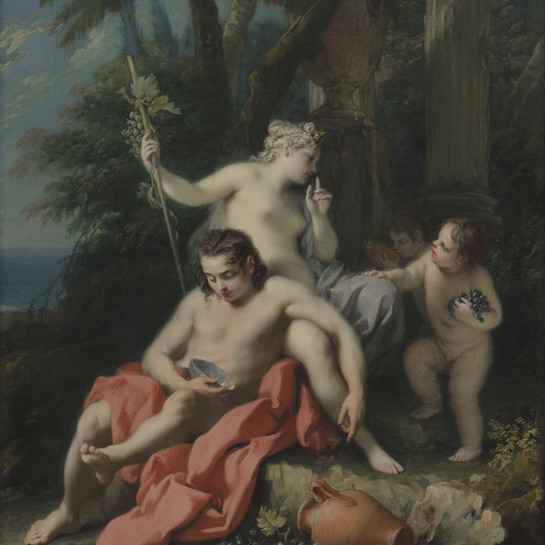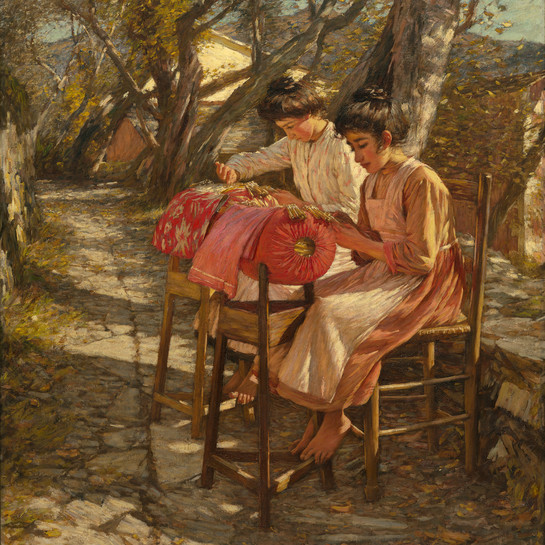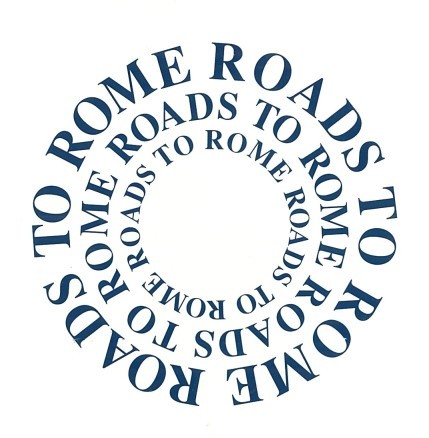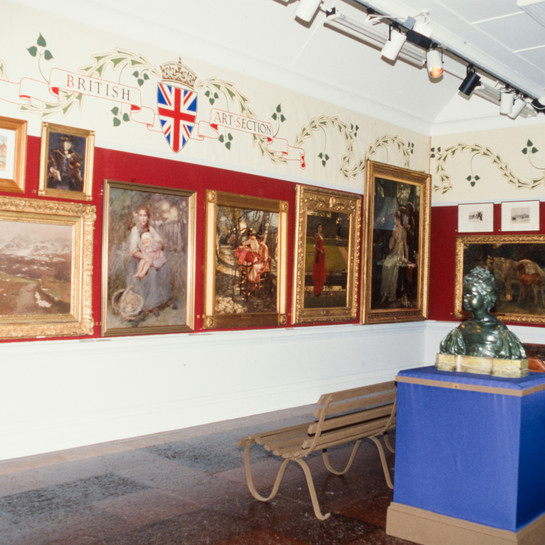Henry H. La Thangue
England, b.1859, d.1929
Making Ligurian Lace
- c. 1905
- Oil on canvas
- Purchased by the Canterbury Society of Arts, 1912, with the J T Peacock bequest; presented to the city, 1932
- 1061 x 913mm
- 69/354
Tags: aprons (protective wear), buildings (structures), chairs (furniture forms), dresses (garments), floral patterns, furniture, girls, lace making, landscapes (representations), needlework (visual works), paths, people (agents), sunlight, textiles (visual works), trees, women (female humans), youth
Henry Herbert La Thangue found naturally disposed and patient sitters in this pair of young women, painstakingly creating the decorative bobbin lace for which coastal Liguria – the Italian Riviera – was renowned. La Thangue took regular inspiration from the lives of working people in England, Italy and France and, like Millet and van der Velden, was particularly drawn to disappearing forms of rural labour. Every winter from 1901, he relocated from the Sussex countryside to the Mediterranean and from 1904 to 1911 he based himself in the steep hillside fishing villages of Liguria. Working en plein air – outdoors – he painted sellers of flowers, oranges and poultry.
(Leaving for work, 2 October 2021 - 1 May 2022)
Exhibition History
Persistent Encounters, 10 March 2020 – 19 September 2021
Henry Herbert La Thangue took artistic inspiration from the lives of working people in England, Italy and France, and was particularly drawn to disappearing forms of rural labour. Every winter from 1901, he relocated from the Sussex countryside to the Mediterranean. From 1904 to 1911 he based himself there in the fishing villages and steep hillsides of coastal Liguria – the Italian Riviera – and painted their industrious residents outdoors. He found naturally picturesque and patient sitters in a region renowned for its fine, decorative bobbin lace.La Thangue first exhibited Making Ligurian Lace in London in 1907. Following a by now established pattern, it was one of twelve works sent from England in 1912 for exhibiting with the Canterbury Society of Arts.
Weight of Sunlight, 15 September 2017 – 16 September
Every year from 1901 the painter Henry Herbert La Thangue left his home in the Sussex countryside, shunning the English winter in pursuit of Mediterranean warmth and light. From 1904 to 1911 he made his base in coastal Liguria – the Italian Riviera – finding inspiration in the fishing villages perched on its steep hillsides; painting outdoors in its invigorating combination of sea and mountain air. In Italy, as in England, La Thangue was drawn to rural life and traditional, disappearing forms of labour; in Liguria, a region renowned for its fine, decorative bobbin lace, this included lacemaking. Influenced by French Impressionism and the work of Jules Bastien-Lepage, La Thangue was a leader in bringing the ideals of French en plein air (‘in the open air’) painting to Britain. Making Ligurian Lace was first exhibited in London in 1907, and was one of twelve paintings sent from England for exhibition at the Canterbury Society of Arts in 1912.
Treasury: A Generous Legacy, 18 December 2015 – 4 December 2016
Shunning the English winter, each year from 1901 the painter Henry Herbert La Thangue would leave his home in the Sussex countryside in pursuit of Mediterranean warmth and light. From 1904 to 1911 he made his winter base in coastal Liguria – the Italian Riviera – finding inspiration in its fishing villages and traditional forms of labour, including lacemaking.
Making Ligurian Lace was first exhibited in London in 1907, and in 1912 was one of twelve paintings sent from England for showing at the Canterbury Society of Arts. Purchased through a bequest from local businessman John T. Peacock (1827–1905), it was presented to the city’s new public art gallery in 1932.
Henry La Thangue lived in Liguria, Northern Italy, from 1903 to 1911. Glossing over any of the harsh realities of such a life, he gives the impression that lace-making was a happy and relaxed occupation. This sentimental mood is enhanced by the dappled sunlight. La Thangue’s interests were in Naturalism, rather than Realism. His concern was to explore his subject through light and colour, rather than making any form of social comment. Born in Croydon, La Thangue attended Dulwich College and went on to study at the South Kensington, Lambeth and Royal Academy Schools. Aged 19 he won the Royal Academy Gold Medal and a scholarship to study in Paris at the École des Beaux-Arts for three years. On returning to England he became a central figure in the New English Art Club which opposed the traditionalism of the Royal Academy. By the 1890s, however, he was exhibiting at the Royal Academy, becoming an Associate in 1898. (Gallery opening hang, 2003)
Painting naturalistic genre scenes, La Thangue followed the ideas of the Barbizon and 'plein air' painters and was influenced by the themes developed by the French artist Bastien-Lepage (1848-1884). He was also interested in the works of the Newlyn School in Britain. By comparison with the realism in Millet's works, La Thange's paintings are somewhat sentimental. Set in Liguria, Northern Italy, where La Thangue lived from 1903 to 1911, the scene does not convey a very honest account of the arduous work of lace making, nor of rural working-class life. Using a modified form of Impressionism, soft glowing colours and with an unusual raking paint-stroke, La Thangue captures very well the effect of dappled sunlight, attempting a naturalistic effect within the confines of 'good taste'. (Label date unknown)







